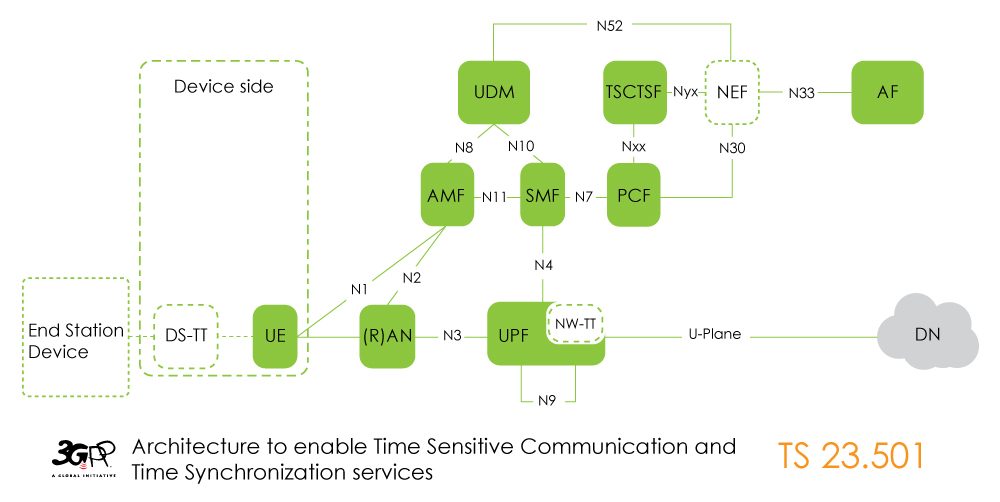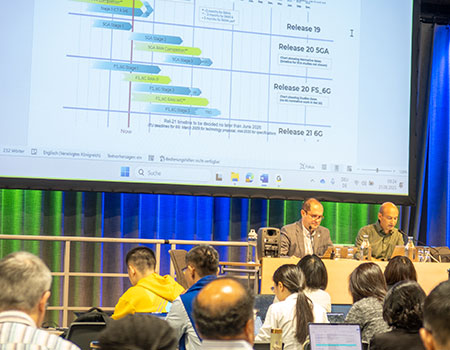Industrial 5G
Enhanced support of Industrial IoT in the 5G System (Rel-17)
By Devaki Chandramouli, Work Item Rapporteur
In Release 17, the 5G System expands the support for Time Synchronization and Time Sensitive communications for any application. The 5G System architecture enables any Application Function (AF) - in the same or different trust domain - to provide its requirements for QoS, traffic characteristics for QoS scheduling optimization, time synchronization activation and deactivation.
If the AF is in a different trust domain from the 5G System, then it provides input via exposure framework, NEF API. If the AF is in the same trust domain as the 5G System, then it provides input directly via the Time Sensitive communication Time Synchronization function (TSCTSF).
The Functional Architecture is shown in the figure below:
Time Synchronization
The figure below depicts the two main synchronization methods supported: the 5GS synchronization and the (g)PTP domain synchronization.
- 5G Clock synchronization: Used for NG RAN synchronization and also distributed to the UE. 5G Clock synchronization over the radio interface towards the UE is specified in TS 38.331.
- (g)PTP synchronization: Provides time synchronization service to (g)PTP network. This process follows the standards IEEE Std 802.1AS or IEEE 1588 operation.
The two synchronization processes can be considered independent from each other and the gNB only needs to be synchronized to the 5G Grand Master (GM) clock.
In order to support (g)PtP time synchronization, the 5G System operates in any of the following modes:
- as time-aware system (IEEE Std 802.1AS).
- as Boundary Clock (IEEE Std 1588).
- as peer-to-peer Transparent Clock (IEEE Std 1588).
- as end-to-end Transparent Clock (IEEE Std 1588).
The 5GS shall be modelled as an IEEE Std 802.1AS or IEEE Std 1588 compliant entity based on the above configuration. The TTs located at the edge of the 5G system (i.e. device side DS-TT and network side NW-TT) are responsible for fulfilling functionalities related to IEEE Std 802.1AS or IEEE Std 1588.
The 5G System is provisioned by the profiles supported by 3GPP specifications that include: Default PTP Profile, IEEE Std 802.1AS PTP profile for transport of timing as defined in IEEE Std 802.1AS, SMPTE Profile for use of IEEE Std 1588 Precision Time Protocol in Professional Broadcast Applications.
Furthermore, (g)PtP time synchronization is supported for the scenarios when Grand Master clock is behind the UE (uplink time sync, UE – UE time sync) and behind the network (down link time sync).
The ability for the AF to influence activation of 5G reference time distribution to the UE(s) along with time synchronization error budget (based on the accuracy needed for the application) has also been introduced.
Time Sensitive Communication QoS
TSC Assistance Information (TSCAI) describes traffic characteristics that may be provided for use by the gNB, to allow more efficiently scheduled radio resources for periodic traffic and applying to PDU session type Ethernet and IP.
TSCAI describes TSC traffic characteristics for use in the 5G System. The knowledge of TSC traffic pattern is useful for 5G-AN to allow it to more efficiently schedule periodic and deterministic traffic flows either via Configured Grants, Semi-Persistent Scheduling or with Dynamic Grants.
5GS determines TSC Assistance Container based on information provided by an AF/NEF and may provide it to PCF for IP type and Ethernet type PDU sessions.
The AF may provide the traffic pattern parameters such as Burst Arrival Time with reference to the ingress port, Periodicity, Flow Direction, Survival Time and Time domain to the NEF. The NEF forwards the received traffic pattern parameters to TSCTSF.
The AF trusted by the operator can be allowed to provide such traffic pattern parameters to TSCTSF directly. The TSCTSF is responsible for determining and forwarding these traffic pattern parameters in TSC Assistance Container to the SMF (via PCF).
Survival Time was also introduced as part of TSCAI in order for the AF to provide the time period an application can survive without any burst. It refers to the time that an application consuming a communication service may continue without an anticipated message. Maximum number of messages (message is equivalent to a burst) or in terms of time units. Single burst is expected within a single time period referred to as the periodicity.
TSC Assistance Information (TSCAI)
| Assistance Information | Description |
| Flow Direction | The direction of the TSC flow (uplink or downlink). |
| Periodicity | It refers to the time period between start of two bursts. |
| Burst Arrival time | The latest possible time when the first packet of the data burst arrives at either the ingress of the RAN (downlink flow direction) or egress interface of the UE (uplink flow direction). |
| Survival Time | Survival Time, as defined in 3GPP TS 22.261 (Service requirements for the 5G system), is synonymous with the time period an application can survive without any burst. |
References
- 3GPP TS 23.501, System Architecture for 5G System; Stage 2 (clauses 4.4.8, 5.27, 5.28)
- 3GPP TS 23.502, Procedures for 5G System; Stage 2
- 3GPP TS 23.503, Policy and Charging Control Framework for the 5G System; Stage 2
- For details of the IEEE work, go to: https://1.ieee802.org/
Further reading: Devaki Chandramouli's earlier article '5G for Industry 4.0', from May 2020.
Acronyms
| 5G-AN | 5G Access Network |
| 5G GM | 5G Grand Master |
| 5GS | 5G System |
| AF | Analytics Function |
| CAG | Closed Access Group |
| DS-TT | Device-Side TSN Translator |
| gNB | Next generation NodeB |
| gPTP | generalized Precision Time Protocol |
| IEEE | Institute of Electrical and Electronics Engineers |
| LAN | Local Area Network |
| NEF | Network Exposure Function |
| NG RAN | Next Generation Radio Access Networks |
| NID | Network identifier |
| NW-TT | Network-Side TSN Translator |
| PCF | Policy Control Function |
| PLMN | Public Land Mobile Network |
| PTP | Precision Time Protocol |
| RAN | Radio Access Network |
| SA2 | Service and System Aspects WG2 (3GPP) |
| SMF | Session Management Function |
| SMPTE | Society of Motion Picture and Television Engineers |
| SNPN | Stand-alone Non-Public Network |
| TSC | Time Sensitive Communication |
| TSCAI | Time Sensitive Communication Assistance Information |
| TSF | Time Synchronization Function |
| TSN | Time Sensitive Networking |
| UE | User Equipment |
| UPF | User Plane Function |
| VN | Virtual Network |
Contact for this article: Kevin FLYNN, Marketing and Communications Officer, 3GPP




 3GPP News
3GPP News




